Convex and concave mirrors (A-level physics)

Reflection at curved mirrors
Curved mirrors are of two types namely;
(i) Concave (Converging) mirror: it is part of the sphere whose center C is in front of its reflecting surface.
(ii) Convex (Diverging) mirror: it is part of the sphere whose center C is behind its reflecting surface.
Consider the reflection of a parallel narrow beam of light at curved mirrors as shown.
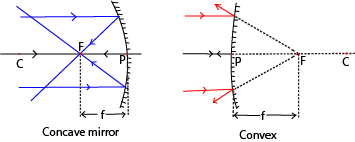
Definitions
- Centre of curvature, C: it is the center of the sphere of which the mirror forms part.
- Radius of curvature, r: it is the radius of the sphere of which the mirror forms part.
- Pole of the mirror: it is the mid-point (center) of the mirror surface.
- Principal axis, CP: it is the line that passes through the center of curvature and the pole of the mirror.
- Secondary axes: These are lines parallel to the principal axis of the mirror.
- Paraxial rays: These are rays drawn close and parallel to the principal axis
- Marginal rays: These are parallel rays furthest from the principal axis of the mirror.
- (i) Principal focus “F” of a concave mirror: it is a point on the principal axis where paraxial rays incident on the mirror and parallel to the principal axis converge after reflection by the mirror.
(ii). Principal focus “F” of a convex mirror: it is a point on the principal axis where paraxial rays incident on the mirror and parallel to the principal axis appear to diverge from after reflection by the mirror
9. (i) Focal length “f” of a concave mirror: it is the distance from the pole of the mirror to the point where paraxial rays incident and parallel to the principal axis converge after reflection by the mirror.
(ii) Focal length “f” of a convex mirror: it is the distance from the pole of the mirror to the point where paraxial rays incident and parallel to the principal axis appear to diverge from after reflection by the mirror.
10 Aperture of the mirror: it is the length of the mirror surface.
Reflection of a parallel wide beam of light at curved mirrors
Consider the reflection of a wide parallel beam of light incident on a concave mirror as shown.
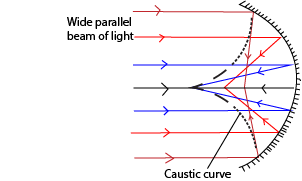
When a wide parallel beam of light is incident on a concave mirror, the different reflected rays are converged to different points. However, these reflected rays appear to touch a surface known as a caustic surface having a cusp (an apex) at the principal focus F.
NOTE
(i) The marginal rays furthest from the principal axis are converged nearer to the pole of the mirror than the paraxial rays.
(ii) Similarly, if a wide parallel beam of light is incident on a convex mirror, the different reflected rays appear to have diverged from different points.
Hyperbolic mirror
This is a type of concave mirror that reflects all the parallel incident beam on to a unique point F, the principal focus of the mirror.
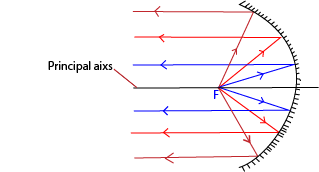
Note that in car headlight and torches, the reflecting surfaces are hyperbolic. When a bulb is placed at the principal focus of reflecting surface, a strong parallel beam of light is obtained. Hyperbolic mirrors are also used in reflecting telescopes.
Example
Explain why the parabolic surface is preferred to concave surface in car headlights?
Solution
The parabolic mirror reflects a wide beam of light of high intensity from a lamp at its principal focus.
A concave mirror reflects the light of low intensity which diminishes with distance since they do not reflect parallel beams when a lamp is placed at their principal focus.
Geometrical rules for the construction of ray diagrams
The following is a set of rules for easy location of the images formed by spherical mirrors
1. Rays parallel to the principal axis are reflected through the principal focus.
2. Rays through the principal focus are reflected parallel to the principal axis.
3. Rays passing through the center of curvature are reflected back along their own paths.
4. Rays incident to the pole are reflected back, making the same angle with the principal axis.
NOTE:
(i) The normal due to reflection at the mirror surface at any point must pass through the center of curvature.
(ii) The image position can be located by the intersection of two reflected rays initially coming from the object.
Real and virtual images
A REAL IMAGE: This is the image formed by the actual intersection of light rays from an object and can be received on the screen.
A VIRTUAL IMAGE: This is the image formed by the apparent intersection of light rays and cannot be received on the screen
Images formed by a concave mirror
The nature of the image formed by a concave mirror is either real or virtual depending on the object distance from the mirror as shown below;
The object between F and P the image is
(a) Behind the mirror
(b) Virtual
(c) Erect
(d) Magnified

The property of a concave mirror to form erect, virtual and a magnified image when the object is nearer to the mirror than its focus makes it useful as a shaving mirror and also used by dentists for teeth examination.
Object at F the image is
(a) at infinity

The object between F and C the image is
(a) Beyond C
(b) Real
(c) Inverted
(d) Magnified
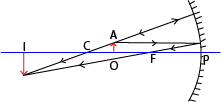
Object at C the image is
(a) At C
(b) Real
(c) Inverted
(d) Same size as the object
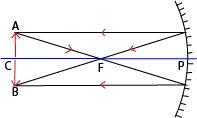
Object beyond C the image is
(a) Between C and F
(b) Real
(c) Inverted
(d) Diminished
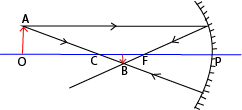
Object at infinity the image is
1) At F
2) Real
3) Inverted
4) Diminished
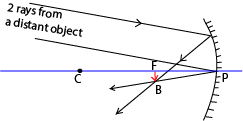
NOTE;
Generally the image of an object in a concave mirror is virtual only when the object is nearer to the mirror than its focus.
Uses of concave mirrors
(i) They are used as shaving mirrors.
(ii) They are used by dentists for teeth examination.
(iii)They are used as solar concentrators in solar panels.
(iv)They are used in reflecting telescopes, a device for viewing distant objects
(v) They are used in projectors, a device for showing slides on a screen.
Images formed by a convex mirror
The image of an object in a convex mirror is erect, virtual, and diminished in size no matter where the object is situated as shown below
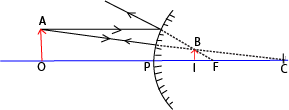
.
In addition to providing an erect image, convex mirrors have got a wide field of view as illustrated below.

Uses of convex mirrors
(i)They are used as car driving mirrors
(ii)They are used in reflecting telescopes, a device for viewing distant objects
Relationship between the focal length f and the radius of curvature r of curved mirrors
Consider the reflection of a paraxial ray, AX, parallel to the principal axis of a concave mirror as shown.

Taking FP = focal length and C = centre of curvature, then , CX, is the normal to the mirror surface and, CP, is the radius of curvature.
tan 2i ≈ 2i


Thus, the radius of curvature of a concave mirror is twice its focal length.
NOTE:
It can be shown that the relation between f and r holds for both concave and
convex mirrors.(This is left as an exercise for the reader)
Mirror formula and sign convention
In order to obtain a formula which holds for both concave and convex mirrors, a Sign rule or convention must be obeyed and the following shall be adopted.
(i) Distances of real objects and images are positive.
(ii) Distances of virtual objects and images are negative.
NOTE: A concave mirror has a positive focal length while a convex mirror has a
negative focal length.
Concave (converging) mirror formula
Consider the incidence of ray OX on to a concave mirror from a point object O placed along the principal axis and then suddenly reflected in the direction XI making an angle q with the normal CX.

Ray OP strikes the mirror incident normally at P and thus reflected back along its own path. The point of intersection I of the two reflected rays is the image position.


NOTE:
The focal length of a concave mirror is a positive distance.
Convex (diverging) mirror formula
Consider the incidence of ray OX on to a convex mirror from a point object O placed along the principal axis and then suddenly reflected in the direction XK making an angle q with the normal XN.


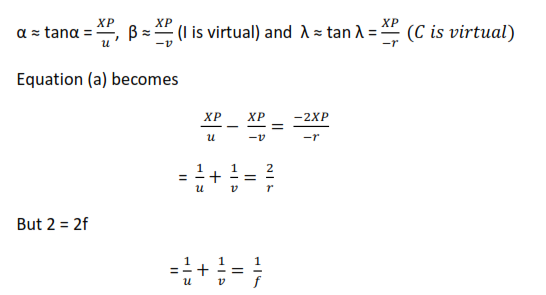
=
Note that the focal length of a convex mirror is a negative distance.
Formula for magnification

Proof
Consider the incidence of ray AP on to the pole of a concave mirror from an object of
height h placed a distance, u, from the mirror and then reflected back making the same angle with the principal axis to form an image of height h1, located at distance, v, from the mirror as shown



NOTE:
(i) No signs need be inserted in the magnification formula.
(ii) Using the mirror formula, a connection relating magnification to the focal length of the mirror with either the object distance or the image distance can be established.
Relationship connecting m, v, and f
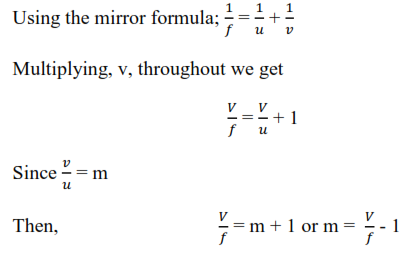
Examples 1
An object is placed 10cm in front of a concave mirror of focal length 15cm. Find the image position and magnification.
Solution:
For a concave mirror, focal length f = +15cm, u = 10cm.

Examples 2
(2) The image of an object in a convex mirror is 6cm from the mirror. If the radius of curvature of the mirror is 20cm, find the object position and the magnification.
Solution:


For a convex mirror, f = – r = – 20 = -10cm
Examples 3
Show that an object and its image coincide in position at the centre of curvature of a concave mirror. Hence find the magnification produced in this case.
Solution
At the centre of curvature of a concave mirror, object distance u = r where r is
the radius of curvature of the mirror.

Thus the image is also formed at the centre of curvature and therefore it coincides in position with its object.

Therefore, the object and its image are of the same size in this case.
Examples 4
A concave mirror forms on a screen a real image of three times the size of the object. The object and screen are then moved until the image is five times the size of the object. If the shift of the screen is 30cm, determine the
(i) focal length of the mirror (ii) shift of the object
Solution

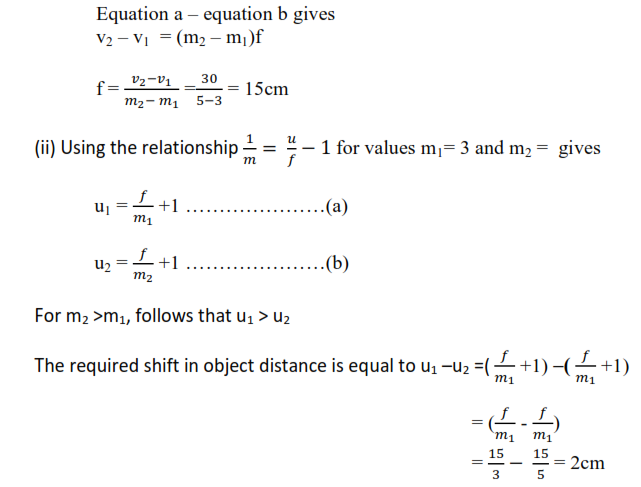
Examples 5
A concave mirror P of focal length 15cm faces a convex mirror Q of focal length
10cm placed 25cm from it. An object is placed between P and Q at a point 20cm from P.
(i) Determine the distance from Q of the image formed by reflection, first in P and then in Q
(ii) Find the magnification of the image formed in (i) above
Solution
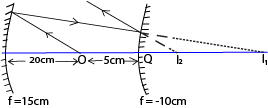
Consider the action of a concave mirror u = 20cm, and f = 15cm

therefore, the image distance from a concave mirror = 60cm
Thus, the image distance behind a convex mirror = 60 – (5 + 20)cm = 35cm.
Consider the action of a convex mirror
The image formed by a concave mirror acts as a virtual object for the convex mirror. Thus u = -35cm and f = -10cm

Examples 6
A small convex mirror is placed 60cm from the pole and on the axis of a large concave mirror of radius of curvature 200cm. The position of the convex mirror is such that a real image of a distant object is formed in the plane of a hole drilled through the concave mirror at its pole.
(a) (i) Draw a ray diagram to show how a convex mirror forms an image of a non- axial point of a distant object
(ii) Suggest a practical application for the arrangement of the mirrors in a (i) above.
(b) Calculate the
(i) radius of curvature of the convex mirror.
(ii) height of the real image if the distant object subtends an angle of 0×5° at the pole of the convex mirror.
Solution
(a)(i)
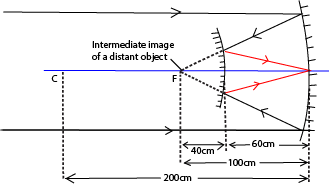
(ii) The mirror arrangement finds application in a reflecting telescope, a device for viewing distant objects
(b) (i) Consider the action of a concave mirror
The image of a distant object is formed at the principal focus of the concave
mirror. This image acts as a virtual object for a convex mirror.
Consider the action of a convex mirror
u = -40cm and v = 60cm

The required radius of curvature r = 240cm
(ii) Consider the magnification produced by a convex mirror
Let h1 = height of the intermediate image formed by a concave mirror as shown.
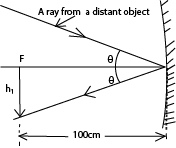
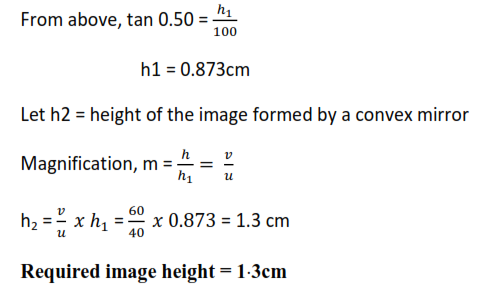
EXERCISE
1.Define the terms centre of curvature, radius of curvature, principal focus and focal
length of a converging mirror.
2.Distinguish between real and virtual images.
3. Explain with the aid of a concave mirror the term a caustic surface.
.4.Explain why a parabolic mirror is used in searchlights instead of a concave mirror
5 An object is placed a distance u from a concave mirror. The mirror forms an image of the object at a distance v. Draw a ray diagram to show the path of light when the image formed is:
(i) real
(ii) virtual
6. Give two instances in each case where concave mirrors and convex mirrors are useful.
7. (i) Explain the suitability of a concave mirror as a shaving mirror.
(ii) Explain with the aid of a ray diagram why a convex mirror is used as a car driving mirror.
8.Show with the aid of a ray diagram, that the radius of curvature of a concave mirror is twice the focal length of the mirror

10. Derive the relation connecting the radius of curvature r object distance u and image distance v of a diverging mirror.

12. (i) Define the term linear magnification.

(iii) A concave mirror of focal length 15cm forms an erect image that is three times the size of the object. Determine the object and its corresponding image position.
(iv) A concave mirror of focal length 10cm forms an image five times the height of its object. Find the possible object and corresponding image positions.
[Ans: (iii) u = 10cm, v = –30cm (iv) u = 12cm, v = 60cm OR u = 8cm, v =–40cm ]
13. A concave mirror forms on a screen a real image which is twice the size of the object. The object and screen are then moved until the image is five times the size of the object. If the shift of the screen is 30cm, determine the
(i) focal length of the mirror
(ii) shift of the object
[Answers: (i) f = 10cm (ii) 3cm ]
14. A concave mirror of radius of curvature 20cm faces a convex mirror of radius of curvature 10cm and is 28cm from it. If an object is placed midway between the mirrors, find the nature and position of the image formed by reflection first at the concave mirror and then at the convex mirror.
[ Answer: A final virtual image is 17×5cm behind the convex mirror ]
15. A small convex mirror is placed 100cm from the pole and on the axis of a large concave mirror of radius of curvature 320cm. The position of the convex mirror
is such that a real image of a distant object is formed in the plane of a hole drilled through the concave mirror at its pole.
(a) (i) Draw a ray diagram to show how a convex mirror forms an image of a non-
axial point of a distant object
(ii) Suggest a practical application for the arrangement of mirrors in a (i) above. (iii) Calculate the radius of curvature of the convex mirror
(b) If the distant object subtends an angle of 3 × 10–3 radians at the pole of the concave mirror, calculate the
(i) size of the real image that would have been formed at the focus of the concave mirror.
(ii) size of the image formed by the convex mirror
[ Ans: (a) (iii) 150cm (b) (i) 0×48cm (ii) 0×8cm ]
Determination of the focal length of a concave mirror.
Method (1) using a pin at C
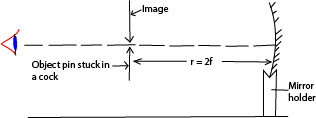
An object pin is placed in front of a mounted concave mirror so that its tip lies along the axis of the mirror. The position of the pin is adjusted until it coincides with its image such that there is no parallax between the pin and its image. The distance r of the pin from the mirror is measured.

NOTE :
(i) In the position where there is no parallax between the object pin and its image, there is no relative motion between the object and its image when the observer moves the head from side to side.
(ii) When the pin coincides with its image, the rays are incident normal to the mirror and are thus reflected along their own path. Therefore the pin coincides with its image at the centre of curvature of the mirror.
Method (2) using an illuminated object at C
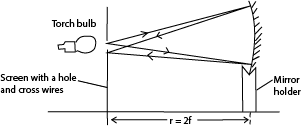
Align an illuminated bulb, a screen and a concave mirror mounted in a holder as shown above. The mirror position is adjusted to or from the screen until a sharp image of the cross-wire is formed on the screen besides the object. The distance r of the mirror from the screen is measured.

Method (3) Using no parallax method in locating V

An object pin P1 is placed at a distance u in front of a mounted concave mirror so that its tip lies along the axis of the mirror. A search pin P2 placed between the mirror and pin p1 is adjusted until it coincides with the image of pin p1 by no-parallax method. The distance v of pin p2 from the mirror is measured. The procedure is repeated for several values of u and the results are tabulated including values of uv, and u+v.
A graph of uv against u+v is plotted and the slope s of such a graph is equal to the focal length f of the mirror.
NOTE:

Determination of focal length of a convex mirror.
Method (1) Using a convex lens.

- The apparatus is arranged as shown above
- An object, O is placed in front of a convex lens L and its image formed at C
- The distance LC is measured and recorded.
- The convex mirror whose focal length, f, is required is placed is placed between L and C with its reflecting surface facing the lens.
- The lens is then moved along the axis, OC until a converging beam incident normally on the mirror forms its image at O
- Distance LP is measured

Method (2) using No parallax.

- An object pin O is placed in front of a convex mirror as shown in the diagram above
- A virtual diminished image is formed at I.
- A plane mirror M is placed between O and P so as to intercept half the field of view of the convex mirror.
- Mirror M is adjusted until its own image of O coincides with I by no parallax method.
- Measure the distances x and y.

Note:
(i) The two images coincides when they are as far behind the plane mirror as
the object is in front.

Examples 7
An object O is placed 40cm in front of a convex lens of focal length 15cm forming an image on the screen. A convex mirror situated 4cm from the lens in the region between the lens and the screen forms the final image besides object O.
(i ) Draw a ray diagram to show how the final image is formed.
(ii) Determine the focal length of the convex mirror.
Solution
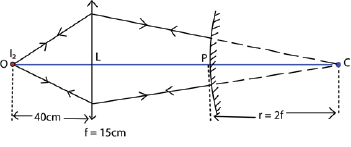
Consider the action of a convex lens u = 40cm, and f = 15cm

Examples 8
A plane mirror is placed 10cm in front of a convex mirror so that it covers about half of the mirror surface. A pin 20cm in front of the plane mirror gives an image in it, which coincides with that of the pin in the convex mirror. Find the focal length of the convex mirror.

Consider the action of a convex mirror
u = 30cm and v = – (20 – 10 ) = -10cm “The image formed is virtual “


EXERCISE
1. Describe an experiment to determine the focal length of a concave mirror.
2.You are provided with the following pieces of apparatus: A screen with cross wires, a lamp, a concave mirror, and a meter ruler. Describe an experiment to determine the focal length of a concave mirror using the above apparatus.
3. Describe an experiment, including a graphical analysis of the results to determine the focal length of a concave mirror using a no parallax method.
4. Describe an experiment to measure the focal length of a convex mirror
5. Describe how the focal length of a diverging mirror can be determined using a convex lens.
6. Describe how the focal length of a convex mirror can be obtained using a plane mirror and the no parallax method.
7. A plane mirror is placed at a distance d in front of a convex mirror of focal length f such that it covers about half of the mirror surface. A pin placed at a distance L in front of the plane mirror gives an image in it, which coincides with that of the pin in the convex mirror. With the aid of an illustration, Show that 2df = d2 – L2

very helpful
I cant download reflection at curved surfaces,could there be a reason that i need to know?
I am not very fantastic with English but I come up this real easy to interpret.
Your insights always hit the mark. Stationary
You have a real talent for this topic. Tech News
Secure your admission with MBBS Admission Through Management/Nri Quota in Madhya Pradesh.
Simplify your application process with MBBS Direct Admission in Gujarat.
Enjoy exclusive benefits by applying the Raja Luck Invite Code.
Improve your video gaming experience with additional advantages utilizing the 82 Lottery Invite Code.